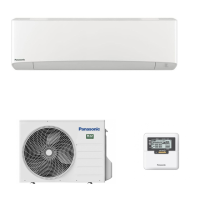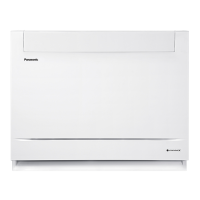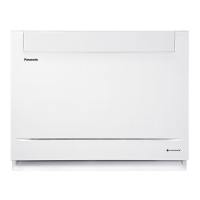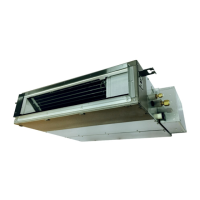86
14.4 Airflow Direction
There are two types of airflow, vertical airflow (directed by horizontal vane) and horizontal airflow (directed by
vertical vanes).
Control of airflow direction can be automatic (angles of direction is determined by operation mode, heat
exchanger temperature and intake air temperature) and manual (angles of direction can be adjusted using
remote control).
14.4.1 Vertical Airflow
(Z20/25/35/42TK)
Operation Mode Airflow Direction
Inner Vane Angle (°) Outer Vane Angle (°)
1 2 3 4 5 1 2 3 4 5
Cooling
Auto 110 ~ 65 50 ~ 85
Manual 110 110 90 70 65 50 62 72 83 85
Dry
Auto 110 ~ 65 50 ~ 85
Manual 110 110 90 70 65 50 62 72 83 85
Heating
Auto with indoor heat
exchanger temp.
A 110 50
B 90 83
C 110 62
Manual 110 110 100 90 80 50 62 72 83 90
(Z50/60/71/80TK)
Operation Mode Airflow Direction
Inner Vane Angle (°) Outer Vane Angle (°)
1 2 3 4 5 1 2 3 4 5
Cooling
Auto 140 ~ 90 47 ~ 74
Manual 140 135 120 105 90 47 58 64 69 74
Soft Dry
Auto 140 ~ 90 47 ~ 74
Manual 140 135 120 105 90 47 58 64 69 74
Heating
Auto with indoor heat
exchanger temp.
A 140 47
B 125 69
C 135 58
Manual 140 135 130 125 105 47 58 64 69 79
1. Automatic vertical airflow direction can be set using remote control; the vane swings up and down within the
angles as stated above. For heating mode operation, the angle of the vane depends on the indoor heat
exchanger temperature as Figure 1 below. It does not swing during fan motor stop. When the air conditioner is
stopped using remote control, the vane will shift to close position.
2. Manual vertical airflow direction can be set using remote control; the angles of the vane are as stated above and
the positions of the vane are as Figure 2 below. When the air conditioner is stopped using remote control, the
vane will shift to close position.
58°C
50°C
30°C
C
B
A
Indoor Heat
Exchanger Temperature
36°C
Figure 1

